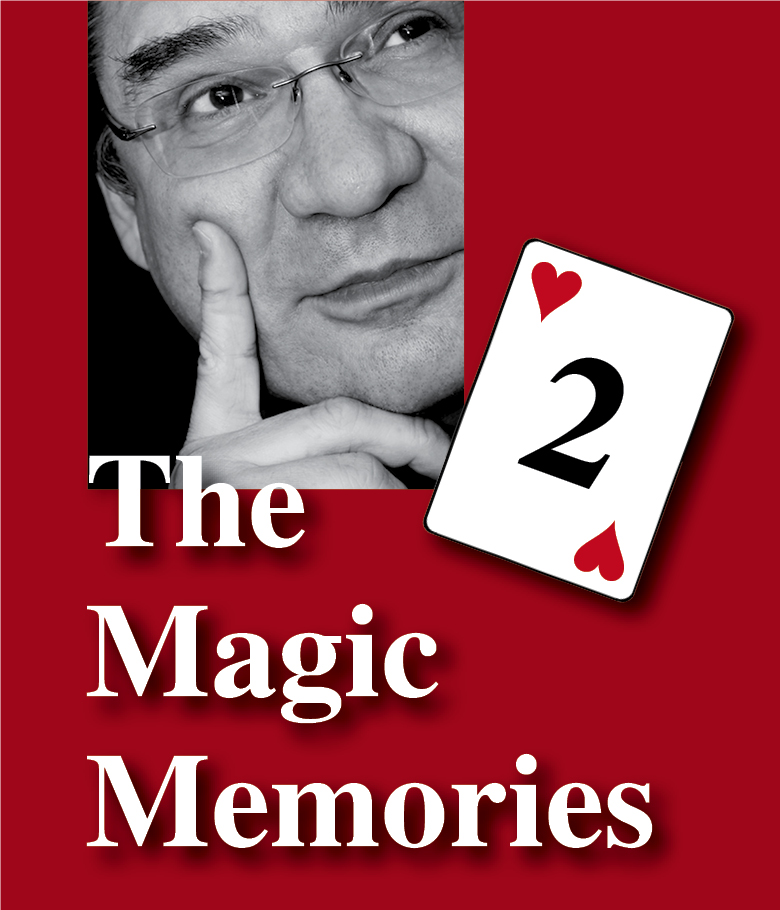
Today’s topics are: Playing cards by Fournier; What’s the use of card clips; More Giobbi Collection photos; Remembering Paolo Morelli (video).
Hello everyone!
These are The Magic Memories 75, gone online Sunday, June 5th, 2022, at 0:07h sharp.
I keep receiving questions from all parts of the world, and as long as I believe that they could be of general interest, I shall be happy to answer them.
Steve Hirsch, in his real life a freelance journalist in Washington, asked: “I use Fournier cards which, as you know, are sturdier and seem better made than standard USPC cards, and even with frequent practice they last longer. I’m wondering if you use a clip or would advise me to skip it.” These are two questions, and I’ll comment on both, one after the other.
Playing Cards by Fournier
Naipes Heraclio Fournier is since the 1940s the largest card manufacturer in Spain, already established in 1870 in Vitoria, the capital of the Alava district in the Basque country, a small hour’s drive from Bilbao. You can read a bit more about it HERE. As always a little search on Internet will provide more details for those who seek it.
After Heraclio’s death in 1916 his grandson Félix Alfaro took over the company, and as an avid collector of playing cards in 1970 established a playing card museum, today owned by the city of Vitoria (MORE HERE).
I have a particular emotional attachment to this place: Not only have I visited it several times in the past thirty years of my regular visits to the city and its Magialdia convention (see The Magic Memories 41 of 2021), I have performed there (see The Magic Memories 44 of 2021 for a discussion of what I did there), and I also gave a 90 minute talk & show – guess you’d call this “infotainment” – on the history and the repertoire of card magicians.
Although in Spanish, I wish I had recorded the event, as I will probably never give this talk again, and it was an interesting one, by my own standards… I do, though, have a very attractive PP presentation, with lots of images and a few video clips, that you might enjoy, even thought the texts are in Spanish and of course there is no talk (I might publish this for you to download for free in an upcoming The Magic Memories if you are interested – let me know).
In 1986 USPCC bought Fournier, and that’s when the quality started to change. After some back and forth Fournier is today (2022) owned by Belgium’s Carta Mundi.
When I first followed Juan Tamariz’s invitation to see him in Spain in 1980, as told in earlier edition of The Magic Memories, staying at his home for a week (!), a “tradition” I have maintained to this day (except the Pandemic Years), he was virtually the only magician using them, while for instance Ascanio and the other Spansh card experts would swear by the then traditional Standard Bicycle Rider Back deck.
When I asked Juan about it, he gave me a little lecture on it, as he so often does when I ask him a question… Briefly, I adopted them and was responsible for bringing them to the German speaking part of Europe through the Cardworkshop.
I started to make up my own special cards and decks when there were none other than normal cards on the market. Later Fournier started to manufacture various kinds of special cards and decks, and nowadays they offer a fine selection for (almost) all needs. This is the reason why I have been using Fournier cards all my life for my performances in front of lay audiences. My professional repertoire consists of only about a dozen card tricks, and I only operate at a maximum of 60% of my technical capacities, whereas my real repertoire for magicians is a hundred times bigger and technically more demanding, so nowadays I use my own Card College Playing Cards (premium stock by USPCC).

Steve, in his question, means the Peacock 505 (see photo above), and like every playing card it has its pros and cons.
What certainly speaks in favor of these cards, is the beautiful back design, in my opinion one of the prettiest, but also its printing quality: If you compare a card by USPCC (left) to one by Fournier (right), you can see the far better resolution and the additional colors, resulting in a much finer appearance (see photo below).
The 505 are also plastic coated, which means that the friction factor is lower than cards with linen finish or similar. This makes them ideal for techniques like Push-through Shuffles, Second Deals or spreads like the Ascanio Spread. Also, they are absolutely flat, so that you can load a face down card between two face up cards, and then place the squared triple on the table as two cards without its real state being noticed – this is virtually impossible with cards by USPCC which mostly have a pronounced bend.

On the other hand, it is precisely the “disadvantages” mentioned above that make cards by USPCC the better choice, such as when making fans. Plus, they are “softer” than the 505, which again facilitates palms, passes and certain false deals.
Then, Fournier’s card box with the large flap is much better for magical use, because you can tear off the side tabs, and the flap will still remain stuck in the box. Whoever invented the shorter flap with the slitted side tabs at USPCC should be given the “cactus award” discerned to the worst design idea of the year (in this case of the century…).
You understand now that I could give a lengthy talk about this subject alone, but it cannot be here. It is moments like these were I wish magic was an academic discipline, and I was employed and paid as a professor by an institution to do this type of work. Instead I do this in my “free” time and because I somehow like doing it (by all means avoid doing things you don’t like doing) and as a courtesy to you. As a consequence there is hardly any editing nor proof-reading – in spite of all this I hope you find this compromise acceptable 🙂
Back to the subject and bottom line: If you ask me for a recommendation of what playing cards to use, after decades of professional experience, I can truthfully state that there is no perfect card, at least I have not found it, and I doubt three will ever be one. (This reminds me of what Bertrand Russell once said: “The whole problem with the world is that fools and fanatics are always so certain of themselves, but wiser people are so full of doubts.”)
Depending from what techniques you specialize in and tricks you perform, some brands work better than others. However, cards being the artist’s instrument, and the instrument the extension of the hand, which in turn is the extension of the mind, the Cardician’s Artistic Trinity, the cards must feel agreeable, comfortable and enjoyable in your hands, you should sense that there is a symbiosis between you and the cards, and that through these cards you can express yourself and what you want to tell your audience by means of your performance. Therefore, give yourself a good budget, buy several brands of cards, and then practice with them over a few years. Given this, you should then be able to decide which type of card suits you best.
And after another ten years you might change opinion. As you can see, this is a reflection of life, as magic reflects in its small world the larger world it is a part of. If all this sounds philosophical to you, it’s because it is. Amen.
Card Clips
A so-called “card press” used to be a common thing in rural or neighborhood restaurants where patrons would gather to play cards, mostly in the afternoon. This is still fairly common in Europe, especially in Switzerland, where people enjoy playing the national game of “Jass”, similar to German “Skat”. The cards are usually provided by the restaurant owner, and to extend durability, after the game they are placed into a “card press”. Below you can see such a card press: A deck is inserted between the separators, so the press can take six or so decks (the photo shows a card from a Swiss deck with 36 cards).

As for almost anything, there is a big collector market for card presses that come in the most beautiful variations, made with precious woods and inlays. My friends in magic Kurt Freitag and Magic Christian, both from Vienna, for instance, have dozens (!) beautiful specimens, and they wouldn’t part with even one for their lives 🙂 Below you can see such a doozy:

This not only goes to show that we have here yet another small world within a big world, as the Japanese like to say, but also that a card press is believed to be useful for card players, and so the cardicians among us should listen. (BTW: The term “cardician” was coined by Edward Marlo and is the title of one of his most important and influential books, The Cardician from 1957.)
Although card presses for a single deck, rather than for several as shown above, are not a new idea, as far as I know the first to adapt it to magic in a “portable” form was Joe Porper (1937 – 2021), possibly following a suggestion by Larry Jennings.
I remember that in the Eighties and early Nineties the “card clips”, as they were then renamed, were no longer available, so I decided to make my own here in Switzerland. Thanks to the know-how of my friend Roger Blättler, a very capable cardician living in my area who had some knowledge of precision engineering, I was able to find a small metal manufacturer who then made me a first batch of 50 units.
Magic friends started to ask me for them, and so, over the years, I had several hundred made, which are now distributed among mostly European cardicians who still use them. Later they started to make good card clips in South America, ans still later in China, so I stopped my production, as I could not compete with their prices (in Switzerland a Cappuccino now costs around $ 7 – I call this “The Cappuccino Index” as opposed to the well-known “big mac index”, because I would eat a big mac only in an emergency).
In the photo below, that shows a few of the dozens of different card clips and card boxes I have accumulated over the years (I’m not a collector, though), on the upper left you can see a chromed card clip from “my” production – the specimen you see was engraved later by my dear friend and mentor Vanni Bossi (more on this extraordinary inventor, performer and historian in a future The Magic Memories) when I gave him four as a gift, he later gave me back two with the engraving of my Ex Libris.
Years later, at a convention in Granada, Spain, one of the two was stolen after a lecture. Maybe the thief now reads these Magic Memories: Well, keep the clip with my blessings, but now you know a bit of the story and hopefully value it even more 🙂
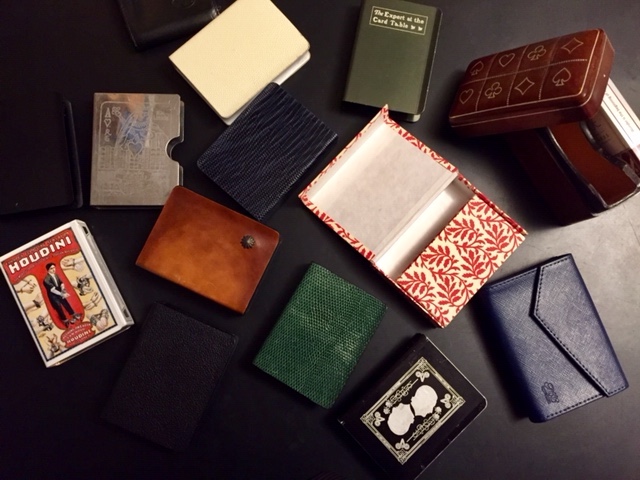
So, this brings us back to Steve’s question of whether we should use card clips in magic or not, and as you can infer from the above, I’m greatly in favor of using card clips.
When I travel, especially by air, but also by any other means, I put every single deck (in its card box, of course) in a card clip – this keeps the cards flat and fresh. Clearly, climatic properties like dryness, due to air conditioning (i.e. in almost the entire New Word…) or humidity, in summer and in areas near the sea, are prone to influence the quality of our cards. Placing them in a card clip nullifies most of these influences and keeps the cards in the best possible condition.
I do not, however, subscribe to the showing off of the card clips in front of an audience, as it makes them look like “magician’s cards” (as always there is the odd exception where it can be made to look good – but you need to “use your head”). This is also true for those elegant and expensive card clips, of which I have a few: I only use them because I like beautiful objects, but a minute before going on, I take the deck in its box out of the clip and put it in my pocket, from which I take it out when I go in front of the audience.
All in all, card clips help keeping the magician’s mot versatile instrument in the best state possible for performance. Even in the worst of atmospheric conditions the deck will be in optimal shape, at least for ten minutes or so, before it will “warp”.
And one more things: Cards that “warped” or are otherwise out of shape, can be placed in a card clip and will usually regain their original optimal state (obviously this will only be the case if you have treated them gently to begin with…).
Now, how was that for an answer if you should use a card clip or not 🙂
More Giobbi Collection Photos
In The Magic Memories (72) I published Ian Kent’s collection of my publications and suggested that anyone who would like could send in his or her photo (BTW: In the past forty years or so I have received virtually thousands of letters and mails by male magicians, but only three or four by women – now you may draw your own conclusions 🙂
Anyway, here are three of the nicest photos I received, much appreciated, and if I was esoterically inclined, by the way the books are presented, I could give a reading of each person…
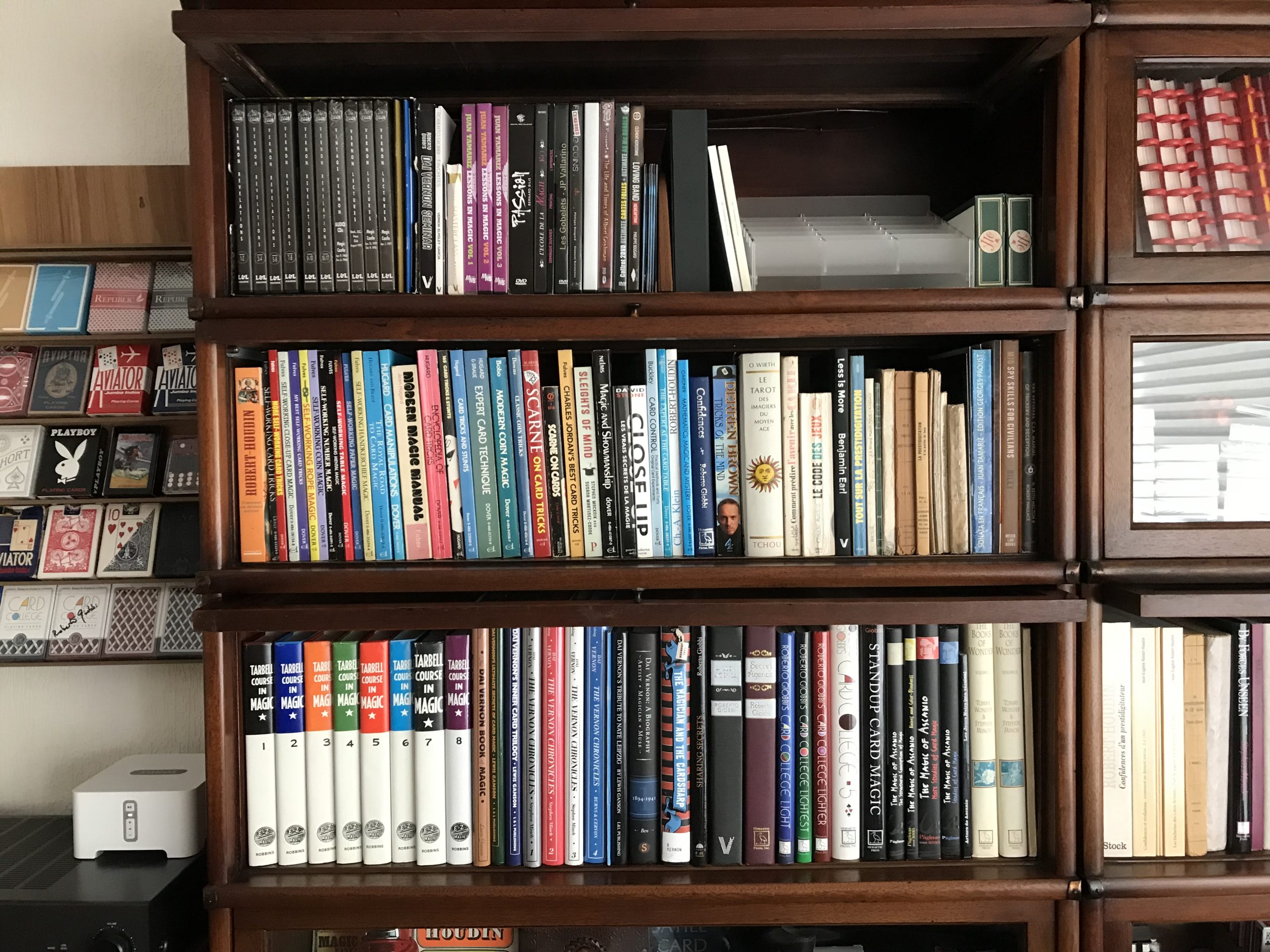
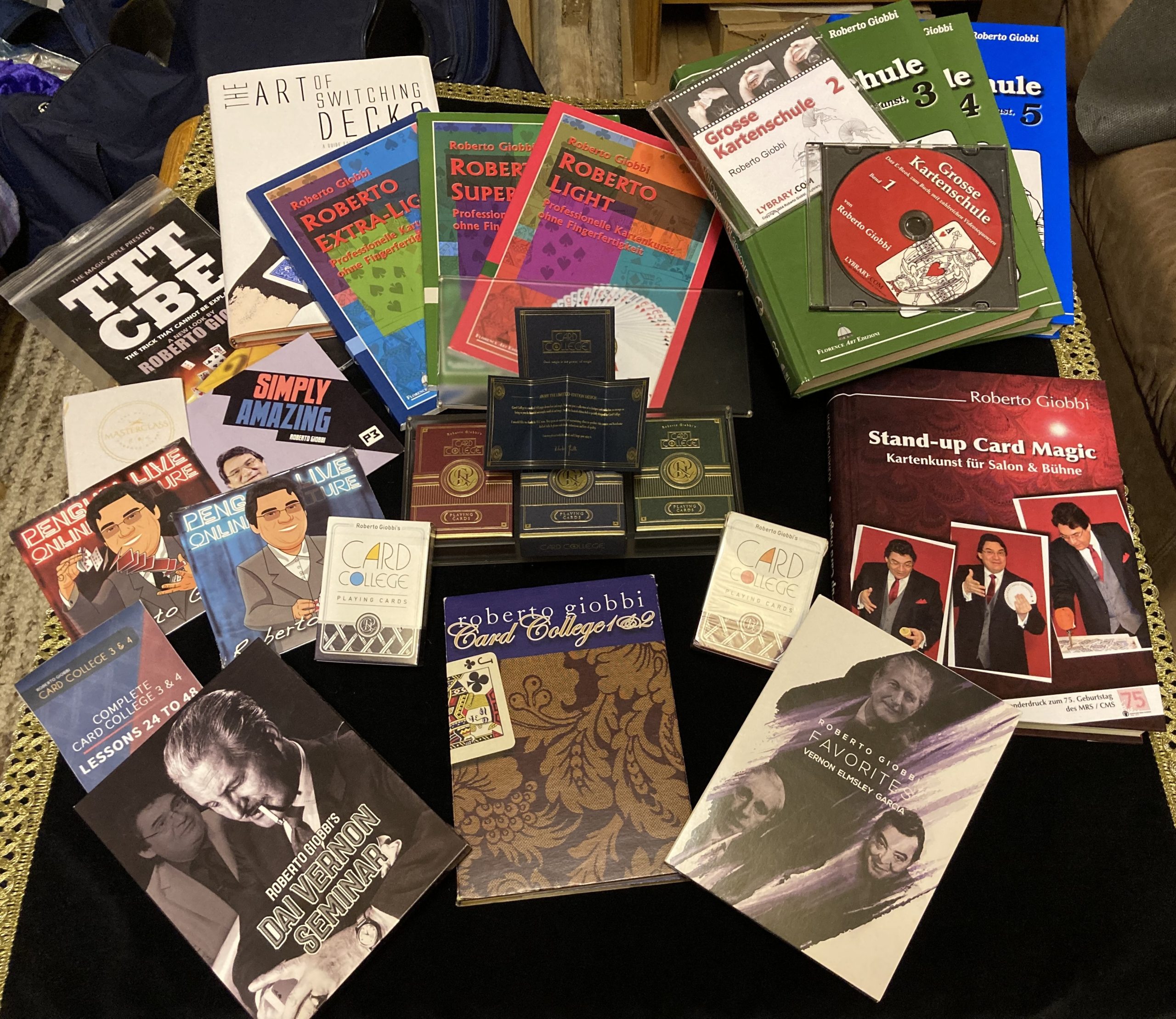
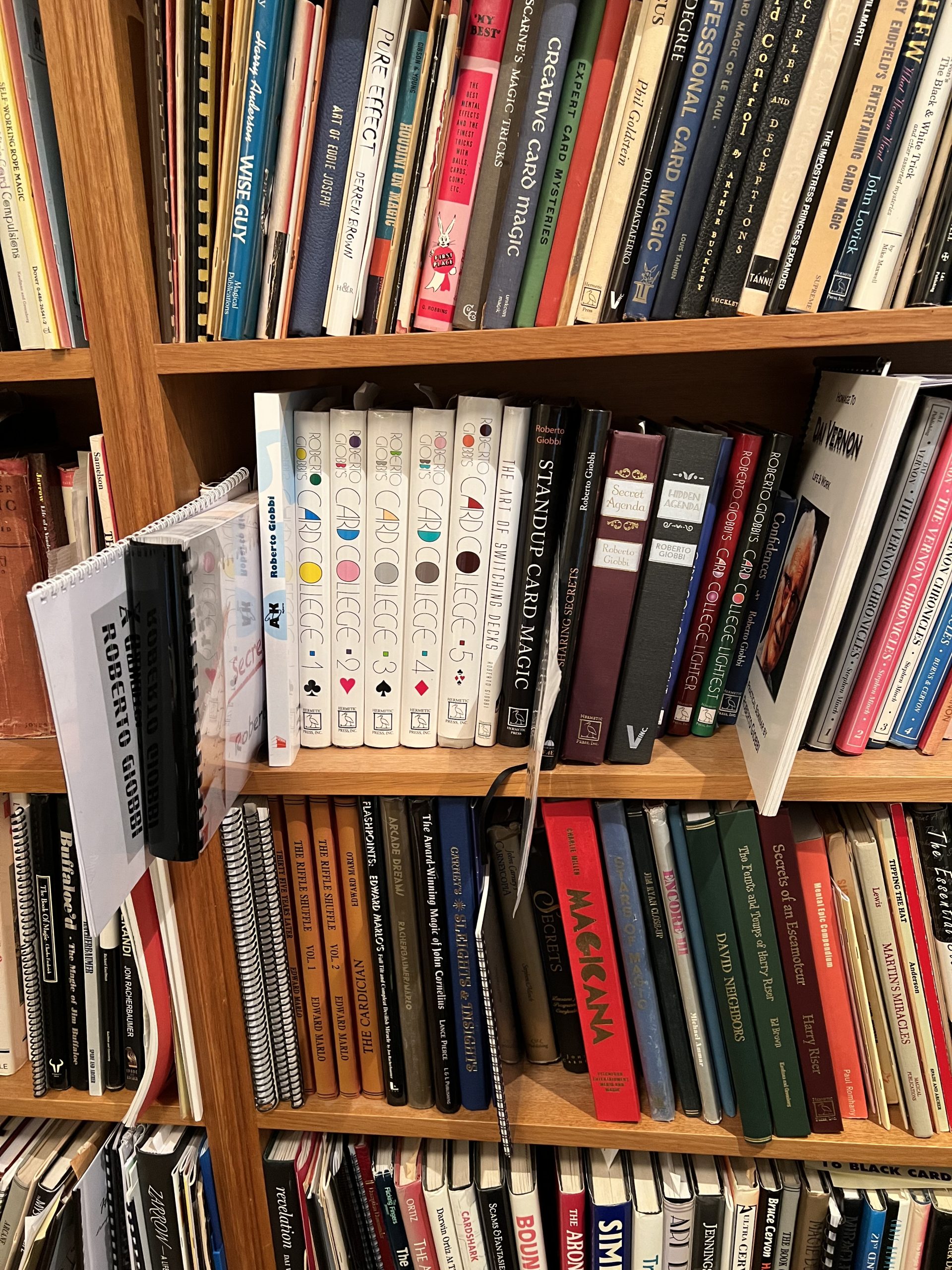
Remembering Giampaolo Morelli
Giampaolo Morelli was an original and extraordinary Italian professional magician whom I had the pleasure of meeting several times during my visits in Italy. You’ll find very little information about him on the Internet, actually almost none, but if you read Italian, there is a short bio in Vinicio Raimondi’s Spettacolo magico (La Porta Magica, Rome 2000).

He was born in the beautiful city of Florence, Italy, on February 1st, 1940 and died in Siena, another iconic city in Tuscany, on April 24th 1999 at the relatively young age of 59.
Still in his twenties he became a professional performer working some of the better night clubs and various of Italy’s top cruise line companies. This gave him a lot of free time which he used to concoct lots of original magic, not only for stage, as you will see in the video below, but also in close-up, card magic taking a special place in his heart.
I felt very flattered when in the early nineties he attended a lecture of mine I gave in Milan, where he lived the latter part of his life.
I remember how we went to a Pizzeria that was opened until late at night, and after an interesting conversation during dinner, he started to show me several of his creations. At the end he gave me one of the very few items he had shared with the fraternity. Collector’s Workshop sold this under the title of “Morelli Ring”, and to this day it remains one of the most practical versions of “Ring to Keychain”.
Other than that there is very little material by this over talented artist around, and I’m currently researching written and video material through his close friend and student Alessandro Daloisio. I had the good fortune of getting together with him a few years later, again on the occasion of a lecture of mine in Florence, but regret that I didn’t take notes as I usually did, so I forgot much of what he did for me. But I certainly remember his charismatic personality, and his card handling and arcane knowledge made me think that he might have also been a very good card player…
Luckily the CLAM (Club Arte Magica) in Milan, of which he was a member, has a little information on him, and with Google translator you can learn a bit more about Morelli (CLICK HERE).
Thanks to Giancarlo Zurzolo, who put up a video on YouTube of Morelli’s stage performance, we can get a glimpse of this man’s talent. For those who take exception to his using doves, please remember that this is from the Seventies and Eighties.
Rather, I’d like you to observe the many original touches in technique, handling and combinations, such as the production of bills. And the double production of doves is the best I’ve ever seen, superior to the classic one using the mouth and done by Pollock, Tomsoni and others.
To enjoy Paolo Morelli’s stage act CLICK HERE.
In Conclusion
All the very best for the next week – and I look forward to our next meeting SUN, 12th June at 0:07h (or later…).
Roberto Giobbi
PS: Please remember that the The Magic Memories are not sent to you automatically, to avoid spam, but you must become proactive by going to www.robertogiobbi.com and click the “News” menu item; or find the list of all posts HERE.

